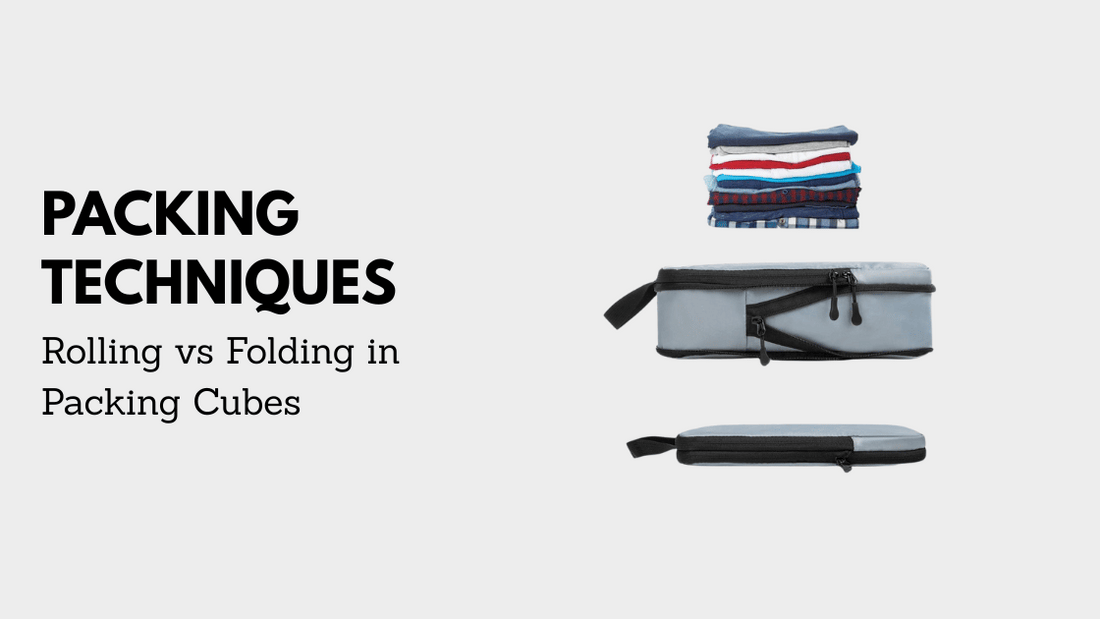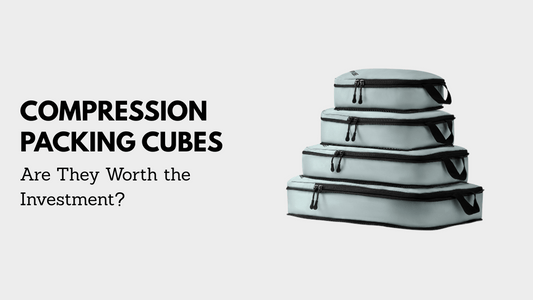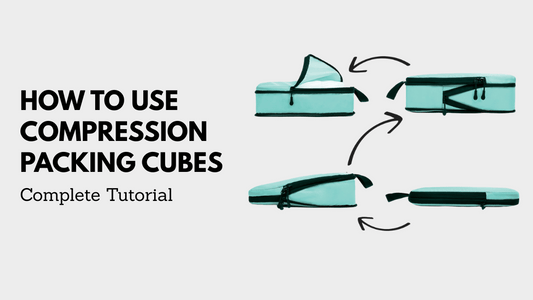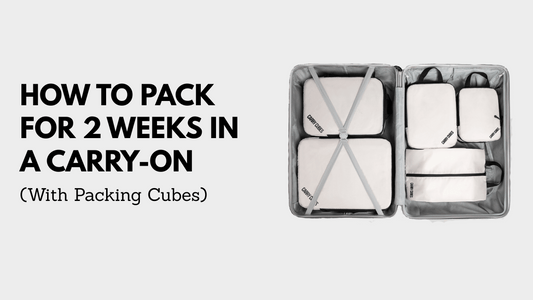
Packing Techniques: Rolling vs Folding in Packing Cubes
Open any travel blog and you'll see the great packing debate: should you roll or fold your clothes? The answer gets more complicated when you add packing cubes to the mix.
After testing both techniques with thousands of items in hundreds of packing cubes, here's exactly when each method works best - and how to avoid the wrinkles that ruin your trip.
Is it better to roll or fold clothes in packing cubes?
For most clothes and most packing cubes, rolling wins. But it's not that simple. The best technique depends on three things:
- What type of clothes you're packing
- What type of cubes you're using
- Whether you care more about space or wrinkles
The rolling advantage
Rolling saves about 15-20% more space than folding, even in regular packing cubes. In compression cubes, the difference is even bigger because rolled clothes compress more evenly.
Roll these items:
- T-shirts and casual tops
- Underwear and socks
- Pajamas and loungewear
- Workout clothes
- Casual dresses
- Lightweight sweaters
When folding works better
Some clothes just fold better than they roll:
Fold these items:
- Dress shirts and blouses
- Pants and trousers
- Structured jackets
- Heavy sweaters
- Items with delicate details
- Anything you want wrinkle-free
Do clothes get more wrinkled in packing cubes?
Yes, but less than you'd think - and way less than clothes packed loose in a suitcase.
The wrinkle reality
Packing cubes actually reduce wrinkles compared to loose packing because:
- Clothes stay in organized bundles instead of shifting around
- Less movement means fewer new wrinkles during travel
- Items don't get crushed under heavy objects
Compression cubes and wrinkles
Compression cubes do create more wrinkles than regular cubes. You're literally squishing clothes into smaller spaces. But you can minimize this with smart techniques.
The fabric factor
Different fabrics wrinkle differently in cubes:
Low-wrinkle fabrics:
- Synthetic blends
- Merino wool
- Knit fabrics
- Stretchy materials
High-wrinkle fabrics:
- Pure cotton dress shirts
- Linen
- Silk
- Structured fabrics with linings
How to pack a suitcase without wrinkling your clothes?
The secret isn't avoiding packing cubes - it's using the right techniques with the right cubes.
The anti-wrinkle rolling technique
- Start with smooth clothes. Give items a quick shake to remove existing wrinkles.
- Lay flat on a hard surface. Your bed is too soft. Use a dresser top or clean floor.
- Fold sleeves in. For shirts, fold sleeves straight back along the side seams.
- Roll from the bottom. Start at the hem and roll toward the collar, pushing out air as you go.
- Roll tight but not crazy tight. Firm pressure removes air without crushing fabric.
- Secure with a rubber band if the item wants to unroll.
The wrinkle-free folding method
- Use a hard surface and smooth out all wrinkles first.
- Fold along natural lines. Use existing creases when possible.
- Add tissue paper between folds for delicate items. Hotel laundry bags work too.
- Stack folded items with heaviest on bottom in the cube.
- Fill empty spaces with socks or underwear to prevent shifting.
Strategic cube placement
- Put delicate cubes on top so they don't get crushed
- Use compression cubes for casual clothes at the bottom
- Keep dress clothes in regular cubes with easier access
Advanced techniques that actually work
The hybrid roll-fold
This works great for button-up shirts:
- Button the shirt completely
- Fold sleeves back along the side seams
- Fold in half lengthwise
- Roll from the bottom up
- The collar stays structured while the body compresses
The bundle wrapping method
For super wrinkle-sensitive clothes:
- Lay your most wrinkle-prone item flat
- Wrap other items around it like layers of an onion
- The outer items protect the inner items from creasing
- Pack the whole bundle in one large cube
The tissue paper trick
Professional packers swear by this:
- Put tissue paper between folds
- Stuff tissue into sleeves and pant legs
- Use hotel laundry bags as tissue paper substitutes
- The paper prevents fabric from pressing against itself
Temperature packing
- Pack clothes while they're slightly warm from the dryer
- Warm fabric holds its shape better when compressed
- Let everything cool down in the cube for maximum wrinkle resistance
- Don't pack hot clothes - just comfortably warm
The layer method for compression cubes
- Layer by weight: Heavy items like jeans at the bottom, light items on top
- Alternate directions: Roll some items left to right, others front to back
- Fill gaps with small items: Socks and underwear fill empty spaces
- Compress gradually: Close the inner zipper, press gently, then use compression zipper
Fabric-specific strategies
Cotton t-shirts and casual clothes
Best technique: Rolling
Cube type: Compression cubes work great
Pro tip: Roll multiple thin items together as one bundle
Dress shirts and blouses
Best technique: Careful folding with tissue paper
Cube type: Regular cubes to avoid over-compression
Pro tip: Button completely before folding to maintain structure
Knit sweaters
Best technique: Loose rolling or flat folding
Cube type: Light compression only - too much stretches the knit
Pro tip: Never hang knits - always pack flat or rolled
Pants and jeans
Best technique: Fold in half lengthwise, then roll
Cube type: Regular cubes (jeans don't compress much anyway)
Pro tip: Pack heaviest pants at the bottom of the cube
Delicate fabrics (silk, linen)
Best technique: Folding with tissue paper protection
Cube type: Regular cubes only
Pro tip: Pack these items last so they're on top and easy to remove first
What about wrinkle-release sprays?
These can help, but technique matters more than products:
When sprays work
- Light wrinkles in synthetic fabrics
- Touch-ups on items that were packed well
- Quick fixes for clothes you need immediately
When sprays don't work
- Deep creases from poor packing
- Natural fabrics that were over-compressed
- Structured items like blazers that need proper hanging
DIY wrinkle release
Mix 1 part fabric softener with 10 parts water in a spray bottle. Works almost as well as commercial sprays and costs way less.
Common packing mistakes that create wrinkles
- Overstuffing cubes: Use multiple cubes or remove items. Overstuffing creates permanent creases.
- Packing damp clothes: Always dry completely first. Moisture sets wrinkles permanently.
- Ignoring fabric types: Use different techniques for different fabrics.
- Poor cube placement: Keep delicate items on top, heavy ones at bottom.
The compression cubes approach
For casual travelers
- Use compression cubes for everyday clothes
- Roll everything except structured items
- Most casual fabrics handle compression fine
For business travelers
- Mix of regular and compression cubes
- Compression for casual clothes, regular for business wear
- Always pack dress clothes with tissue paper or garment folders
For family travelers
- Color-code cubes by family member
- Use compression for kids' clothes
- Keep one regular cube for "nice" clothes
Quick reference guide
- T-shirts: Roll tight, compression cube, bottom of suitcase
- Dress shirts: Fold with tissue, regular cube, top of suitcase
- Underwear/socks: Roll or stuff in gaps, any cube type
- Pants: Fold lengthwise then roll, regular cube
- Sweaters: Loose roll or fold, light compression only
- Pajamas: Roll tight, compression cube
- Workout clothes: Roll tight, compression cube
The bottom line on wrinkles
Perfect wrinkle-free packing doesn't exist, but you can get close with the right techniques:
- Match your technique to your clothes - don't roll everything or fold everything
- Use the right cubes for each item - compression for casual, regular for delicate
- Pack strategically - heavy items on bottom, delicate on top
- Practice at home before important trips
The goal isn't zero wrinkles - it's clothes that look good enough to wear without major touch-ups.
Want to master the complete packing system? Check out our ultimate guide to packing cubes for everything you need to know about organized, wrinkle-free travel.
Ready to upgrade your packing game?





